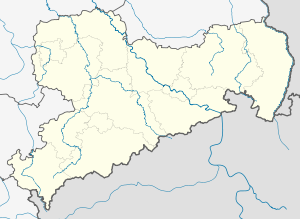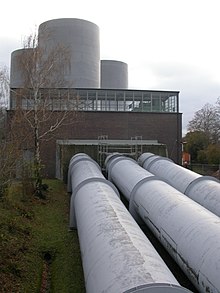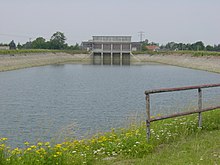Niederwartha pumped storage plant
| Niederwartha pumped storage plant | |||
|---|---|---|---|
| PSP Niederwartha - power plant in the lower basin | |||
| location | |||
|
|
|||
| Coordinates | 51 ° 5 '36 " N , 13 ° 36' 37" E | ||
| country |
|
||
| place | Niederwartha | ||
| Waters | Elbe | ||
| Data | |||
| Type | pumped storage power plant | ||
| Primary energy | Hydropower | ||
| power | 40 megawatts | ||
| owner | Vattenfall | ||
| operator | Vattenfall Wasserkraft GmbH | ||
| Project start | 1927 | ||
| Construction time: | 1927-1930 | ||
| Start of operations | 1958 | ||
| turbine | 2 × Francis turbine | ||
| Website | Vattenfall | ||
| was standing | 2019 | ||
|
Upper and lower basins |
|||
The Niederwartha pumped storage plant is one of the first large-scale pumped storage power plants (abbreviation: PSW). It is located in the Dresden districts of Cossebaude and Niederwartha . The Niederwartha PSP was built from 1927 to 1930 and has a nominal output of 120 megawatts , which can be generated by six machine sets. However, four of them are closed. The PSW Niederwartha is currently in transitional operation with two turbines and 40 MW output.
history
At the time of construction, the engineers at the Niederwartha PSP fought a real race for the first commissioning with the Koepchenwerk PSW on the Ruhr (at Hengsteysee ) in Herdecke, Westphalia . According to information from today's operator Vattenfall , the Niederwartha PSW finally went online with the first machine on November 27, 1929. The final completion and commissioning of the last machine set did not take place until March 1930. The Koepchenwerk was fully commissioned on January 28, 1930 with 132 MW. Logically - depending on the point of view - both power plants were celebrated as “first of their kind” and “great technical innovation” .
The architectural design of the power plant goes back to a design by the Dresden architect and university professor Emil Högg . As a civil engineer, Prof. Kurt Beyer was significantly involved in the construction.
In 1945 the electrical equipment was dismantled as a reparation payment and taken to the Soviet Union. In the years 1957–1960 step-by-step reconstruction, initially with four new machines; later the four original came back from the Soviet Union, two came from the company Escher Wyss and two from Voith . The aggregates of the company Escher-Wyss were scrapped and a new pipe track was built for the other two and the machine house on the Elbe side was extended for these two old machine sets. Now all units are from Voith. In 1955 (?) Two turbines were in operation (40 MW), in 1957 four (80 MW) and in 1960 six (120 MW) for the first time. Originally the old turbines received back only had an output of 15 MW; they were expanded to 20 MW each during the reconstruction. The network connection to the high-voltage network of ENSO Netz takes place via the Niederwartha switchgear.
In August 2002 the power plant was damaged by the Elbe floods . From November 2003 it was gradually put back into operation with two turbines, the remaining ones were not repaired. After plans for a new building were presented in 2008, Vattenfall announced in 2015 that the plant would be taken off the grid on January 1, 2016. However, Vattenfall is obliged to keep the plant available in the event of a black start . A corresponding contract was concluded with DREWAG - Stadtwerke Dresden GmbH.
At the beginning of 2019, the future of the pumped storage plant was still uncertain. Vattenfall does not consider major maintenance measures to be feasible under the given energy industry framework.
The hydraulic structures
The Niederwartha pumped storage power plant consists of an upper basin and a lower basin. These are connected with pressure pipelines: today there are three steel pipelines, 3.20 and 2.50 m in diameter and 1760 m in length. The height of fall is about 143 m.
At the top of the mountainside, at the kink of the downpipes, there is an open tower on each pipe, the so-called water tower . It is used to prevent a pressure surge in the pipe when a valve is closed. Otherwise pressure surges could cause a pipe to break.
The power plant works with Francis turbines . According to fluctuating figures, the energy storage capacity ( working capacity ) of the system is 560 or 591 MWh.
The lower basin
At the time of construction, about half of the lower basin was built on Kötzschenbrodaer Flur, the entire north-western part of the basin covers around half of the former pond meadows on the left Elbe of the later Radebeul district of Am Fährhaus . The Reidl's Hof located there was also flooded. The 45 ha storage area corresponds roughly to the 43 ha Kötzschenbrodaer Flur, which began directly on the Elbe and was upstream of the Niederwarthaer Elbe bridge . In 1954 this entire corridor came to Niederwartha and is now part of Dresden.
The barrier structure of the lower basin is a dam . The Elbe flowing nearby is not dammed.
At the lower basin (Cossebaude reservoir) there has been a bathing establishment since 1936, which today belongs to the city of Dresden. In 2002 and 2013 the pool was flooded by the Elbe floods.
The building data:
- Construction type: earth dam
- Height above foundation level: ...
- Height above valley floor: 8 m
- Crown length: 2500 m
- Building volume: ...
- Storage space: 2.5 million m³
- Storage surface: 45 ha
The upper basin
The barrier structure of the upper basin is also a dam. Three small streams run towards the upper basin, of which the Unkersdorfer Silberbach is the largest. At the inlet of these three tributaries there is a pre-dam near Rennersdorf.
There are also swimming opportunities in the upper basin, albeit of an unofficial nature. The operator Vattenfall tolerates wild bathing.
The building data:
- Construction type: Zone dam made of loam, clay, sand, crushed stone and gravel
- Crown height: 256.50 m above sea level NN
- Height above valley floor: 42 m
- Crown length: (at least) 800 m
- Crown width: 10 m
- Structure volume: 550,000 m³
- Storage space: 2.9 million m³, according to other information: 2.84 million m³
- Storage surface: 30 ha
See also
- List of bodies of water in Saxony
- List of pumped storage power plants
- List of hydropower plants in Germany
- List of dams in Germany
Web links
Individual evidence
- ↑ a b Niederwartha pumped storage power plant. In: vattenfall.com. Retrieved December 11, 2019 .
- ↑ List of power plants. Federal Network Agency , November 11, 2019, accessed on December 11, 2019 .
- ↑ Jana Mundus: It pumped out. The energy company Vattenfall finally knows what will become of the pumped storage plant - not much anymore. Sächsische Zeitung , August 28, 2015, accessed on November 12, 2015 .
- ↑ Kajetan Byszio: Fight for the Niederwartha pumped storage power plant. In: Saxony television . February 6, 2019, accessed December 11, 2019 .






